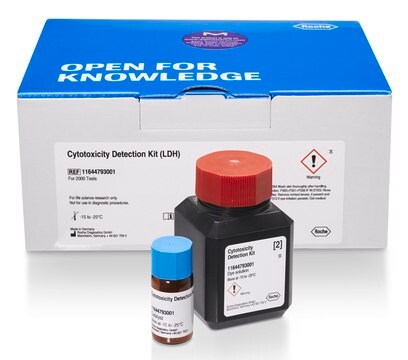PA0100
Plant Cell Viability Assay Kit
Fluorescent staining system to highlight viable and non-viable cells
Se connecterpour consulter vos tarifs contractuels et ceux de votre entreprise/organisme
About This Item
Code UNSPSC :
10171502
Nomenclature NACRES :
NA.84
Produits recommandés
Niveau de qualité
Température de stockage
−20°C
Description générale
The Plant Cell Viability Assay Kit is designed for the differential viability staining of plant cells. The kit employs a dual color fluorescent staining system to highlight viable and non-viable cells. This procedure has been used to stain intact plant tissue, callus tissue, cell suspension culture, and protoplasts.
Application
Viable cells are living cells with intact plasma membranes. These cells can be distinguished by the presence of intracellular esterase activity. This activity is assayed through the enzymatic hydrolysis of fluorescein diacetate or related compounds, such as carboxyfluorescein or calcein AM. These lipophilic compounds are membrane-permeable and non-fluorescent. In the plant cell, they are hydrolyzed to highly polar fluorescent compounds. Because of their polar nature, these compounds are unable to diffuse across the plasma membrane and are retained within viable cells, producing an intense green fluorescence within the cytoplasm. Fluorescein diacetate was found to be the optimal dye for staining viable plant cells. It does not photobleach as quickly as calcein AM, and produces much less background fluorescence than carboxyfluorescein diacetate in plant cells. Non-viable cells could be either living or dead. They can be distinguished from viable cells by their non-intact or damaged plasma membranes. Propidium iodide and related compounds, such as ethidium homodimers-1 and -III, can only enter cells with damaged membranes, whereupon they intercalate into double-stranded nucleic acids. This results in a bright red fluorescence in non-viable cells, particularly in the nucleus where the concentration of nucleic acids is highest. Propidium iodide is the optimal dye for staining non-viable plant cells. In plant cells it specifically labels nucleic acids, whereas ethidium homodimers-1 and -III both bind non-specifically to the plant cell wall.
Autres remarques
The components of this kit must be protected from light and stored at -20 °C with desiccant. Propidium iodide is stable in aqueous solution. However, fluorescein diacetate will hydrolyze in aqueous solution. Dilutions of the dyes should be used within one day.
Code de la classe de stockage
10 - Combustible liquids
Classe de danger pour l'eau (WGK)
WGK 2
Point d'éclair (°F)
188.6 °F
Point d'éclair (°C)
87 °C
Certificats d'analyse (COA)
Recherchez un Certificats d'analyse (COA) en saisissant le numéro de lot du produit. Les numéros de lot figurent sur l'étiquette du produit après les mots "Lot" ou "Batch".
Déjà en possession de ce produit ?
Retrouvez la documentation relative aux produits que vous avez récemment achetés dans la Bibliothèque de documents.
Les clients ont également consulté
E A Brisibe et al.
Journal of experimental botany, 51(343), 187-196 (2000-08-12)
Three types of callus tissues established from anther culture of eleven doubled haploid (DH) lines of wheat (Triticum aestivum L.) were evaluated for their ability in enhancing friable embryogenic (Type II) culture differentiation and genetic transformation. Differences between types of
Estimating viability of plant protoplasts using double and single staining.
Huang, C.-N., et al.
Protoplasma, 135, 80-87 (1986)
H Koyama et al.
Journal of experimental botany, 52(355), 361-368 (2001-04-03)
The viability of Arabidopsis thaliana (strain Landsberg) roots exposed to a low pH (4.5 or 4.7) solution that contained 100 microM CaCl(2) was examined by staining with fluorescein diacetate-propidium iodide. The elongation zone of growing roots lost viability within 1-2
K H Jones et al.
The journal of histochemistry and cytochemistry : official journal of the Histochemistry Society, 33(1), 77-79 (1985-01-01)
A rapid, simultaneous double-staining procedure using fluorescein diacetate (FDA) and propidium iodide (PI) is described for use in the determination of cell viability in cell suspension. Air-dried slide preparations can be made from the cell suspensions so that an accurate
S. M. Regan et al.
The Plant cell, 2(9), 877-889 (1990-09-01)
Microsporogenesis has been examined in wild-type Arabidopsis thaliana and the nuclear male-sterile mutant BM3 by cytochemical staining. The mutant lacks adenine phosphoribosyltransferase, an enzyme of the purine salvage pathway that converts adenine to AMP. Pollen development in the mutant began
Notre équipe de scientifiques dispose d'une expérience dans tous les secteurs de la recherche, notamment en sciences de la vie, science des matériaux, synthèse chimique, chromatographie, analyse et dans de nombreux autres domaines..
Contacter notre Service technique
